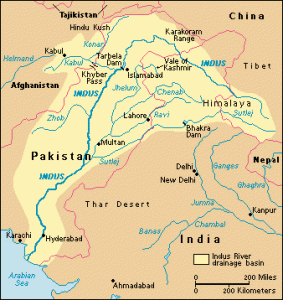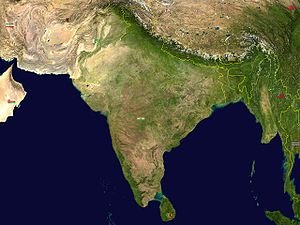What is India?
India is officially the Republic of India (Bharat Ganrajya). Let’s have a quick look at the topic “What is India” – an analysis which extends from the origin of the term to the concept of “India”.
Origin of the term “India”

Indus River : Courtesy: howstuffworks.com
There are three versions for the origin of the term – Latin, Greek and Persian – all versions pointing the origin of the word to the name of Indus river (River Sindu). The term India finds mention in history as the region around and beyond river Indus, by 2nd century AD. (Mentions in – Latin : Lucian, Greek : Herodotus, Persian : Darius). The word “Hindu” also has its etymology behind the Sindu river and the land of Hindus are also known by the name Hindustan.
Origin of the term “Bharat”
The term Bharat or Bharata is believed to be derived from the ruler Bharata, son of Dushyanth and Shakuntala (Epic of Mahabharata). All the areas mentioned in the texts to be ruled by him were later known by the term Bharat. The term in Classical Sanskrit literature comprises the present day territories (full or part) of Afghanistan, Pakistan, Republic of India, Nepal and Bangladesh.
Concept of India
There is a general misunderstanding that the concept of India or the feeling of nationality didn’t exist in India before British Indian empire. It’s clear by now that the concept of India as a nation existed centuries before the European arrival. Even Columbus started his journey for finding a shorter route to India and called the land he reached as India (which was actually the present day America).
Political Boundaries of India

Indian Subcontinent
Political boundaries of no nation is fixed, and that is particularly true with respect to India. During the times of kingships and battles, frontiers continuously changed. There were times when the empires extended from the modern day Afghanistan in the west to Burma in the east. Though the term India is widely used for the whole land mass in the Indian subcontinent, rule of this vast land by a single ruler or authority didn’t happen quite often. A single authority rule of a larger area of Indian subcontinent happened during Maurya Empire under emperors Chandragupta Maurya and Ashoka the Great (4th to 3rd centuries BC), Mughal Empire (17th century), the Maratha Empire (18th century), and the British Raj (19th to 20th centuries).
India – Pakistan – Bangladesh (IPB)
The present day India’s boundaries are marked by two countries – Pakistan in the west and Bangladesh in the east. Both these countries still cherish an in-separable part of Indian history and culture. Indus Valley Civilization was spread across the lands of Pakistan and India. The three countries were part of the British Indian empire and fought the freedom struggle together as a single unit. But the earlier British policy of “Divide and Rule” paved way to division of Indian landmass into India and Pakistan. Bangladesh was formed later from Pakistan. Despite the brotherhood cherished by a majority of people in these three countries, regional political aspirations as well as interests of the west are playing a crucial role in creating problems across the borders.
Republic of India and Islamic Republic of Pakistan
Religion played a major role in the creation of Pakistan in 1947, which later became the Islamic Republic of Pakistan. India, though a land of 81% Hindus and 17 % Muslims didn’t became a Hindu Republic, but preferred to continue as a Secular Republic. Clauses were added in Indian constitution for free worship of all religions as well as for the protection of minorities – which includes Muslims, Christians, Buddhists, Jains and Parsees.
Why Burma not part of modern India?
Though Burma was part of British India in the earlier period, it was separated in 1937.
India – as a Country vs Nation
A country may lose or gain territories in course of time, but a nation cannot. Nation is a region where people have a feeling of oneness. That feeling cannot be imposed and it should come from within. India is a land of different races, different religions and different languages. There may be a few parochial secessionist tendencies, and but there are a lot of strong elements which holds India as a single unit. And at this age when no region can stay independent, this broader outlook and unity is driving India towards progress. After the long years of kingship and British rule, we have lost and gained a few territories, but the present day India is standing tall as model of long history, heritage, tolerance and secularism.